AMD FX-8320E CPU Review: The Other 95W Vishera
by Ian Cutress on January 13, 2015 10:00 AM ESTF1 2013
First up is F1 2013 by Codemasters. I am a big Formula 1 fan in my spare time, and nothing makes me happier than carving up the field in a Caterham, waving to the Red Bulls as I drive by (because I play on easy and take shortcuts). F1 2013 uses the EGO Engine, and like other Codemasters games ends up being very playable on old hardware quite easily. In order to beef up the benchmark a bit, we devised the following scenario for the benchmark mode: one lap of Spa-Francorchamps in the heavy wet, the benchmark follows Jenson Button in the McLaren who starts on the grid in 22nd place, with the field made up of 11 Williams cars, 5 Marussia and 5 Caterham in that order. This puts emphasis on the CPU to handle the AI in the wet, and allows for a good amount of overtaking during the automated benchmark. We test at 1920x1080 on Ultra graphical settings.
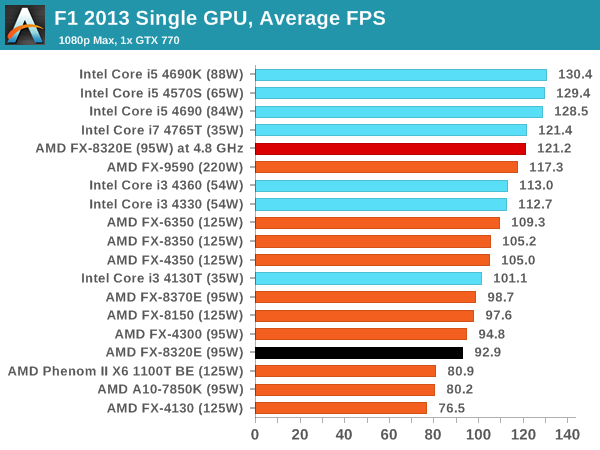
In both single and dual GPU cases, the stock performance of the FX-8320E falls behind the i3 CPUs by a 10-20 FPS margin, perhaps being noticeable on 120 Hz monitors. The minimum FPS on a single GPU still retains above 60 FPS, which is a plus.
Bioshock Infinite
Bioshock Infinite was Zero Punctuation’s Game of the Year for 2013, uses the Unreal Engine 3, and is designed to scale with both cores and graphical prowess. We test the benchmark using the Adrenaline benchmark tool and the Xtreme (1920x1080, Maximum) performance setting, noting down the average frame rates and the minimum frame rates.
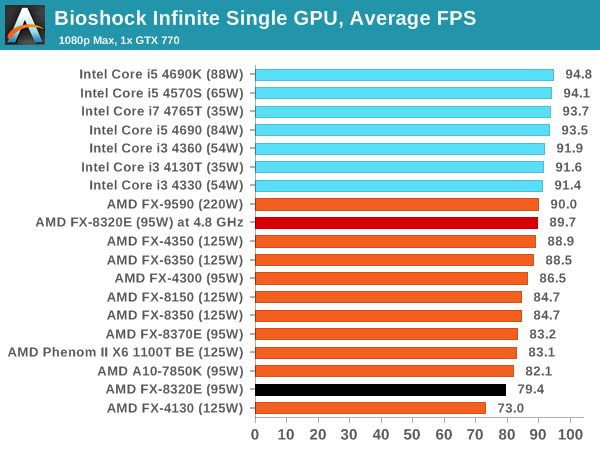
While average frame rates almost appear to be CPU agnostic, there is a clear AMD/Intel split here. More interesting is the minimum FPS results which seem to rely on IPC.
Tomb Raider
The next benchmark in our test is Tomb Raider. Tomb Raider is an AMD optimized game, lauded for its use of TressFX creating dynamic hair to increase the immersion in game. Tomb Raider uses a modified version of the Crystal Engine, and enjoys raw horsepower. We test the benchmark using the Adrenaline benchmark tool and the Xtreme (1920x1080, Maximum) performance setting, noting down the average frame rates and the minimum frame rates.
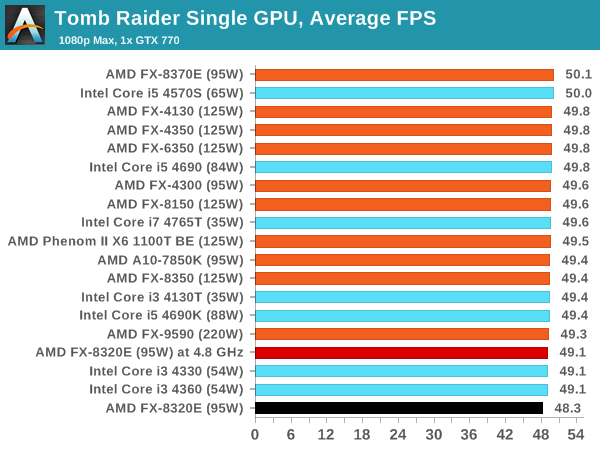
Tomb Raider still comes across as purely CPU agnostic.
Sleeping Dogs
Sleeping Dogs is a benchmarking wet dream – a highly complex benchmark that can bring the toughest setup and high resolutions down into single figures. Having an extreme SSAO setting can do that, but at the right settings Sleeping Dogs is highly playable and enjoyable. We run the basic benchmark program laid out in the Adrenaline benchmark tool, and the Xtreme (1920x1080, Maximum) performance setting, noting down the average frame rates and the minimum frame rates.
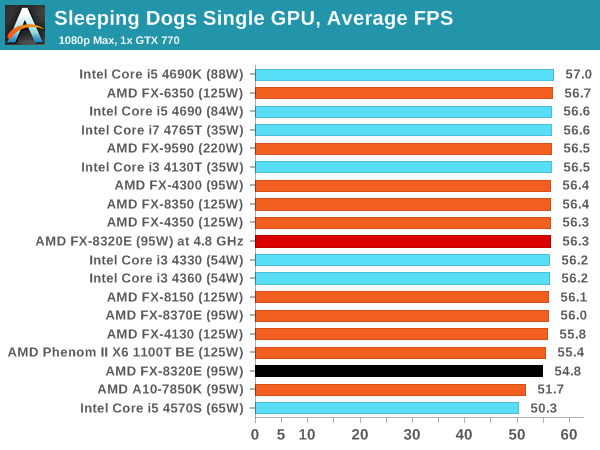
Single GPU usage puts the 8320E in the ballpark, but moving to dual GPUs sees an uplift in terms of the i5 CPUs for high refresh rate screens, albeit with the extra cost associated.
Battlefield 4
The EA/DICE series that has taken countless hours of my life away is back for another iteration, using the Frostbite 3 engine. AMD is also piling its resources into BF4 with the new Mantle API for developers, designed to cut the time required for the CPU to dispatch commands to the graphical sub-system. For our test we use the in-game benchmarking tools and record the frame time for the first ~70 seconds of the Tashgar single player mission, which is an on-rails generation of and rendering of objects and textures. We test at 1920x1080 at Ultra settings.
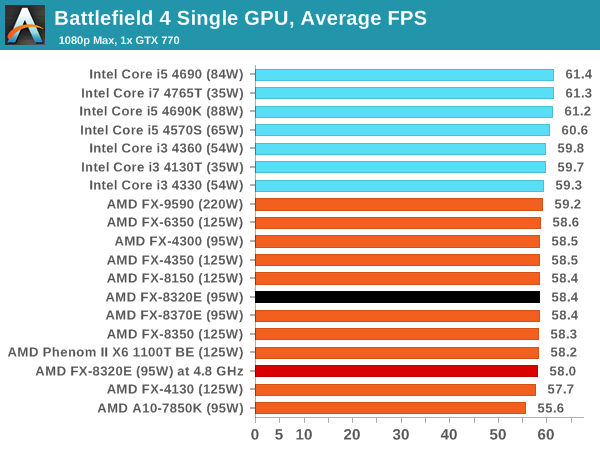
Single GPU shows little difference (despite a clear AMD/Intel separation line), but in dual GPU mode an i3 will make a 17 FPS rise, moving to 27 FPS with the i5 and more relevant to high refresh displays.















92 Comments
View All Comments
OrphanageExplosion - Wednesday, January 14, 2015 - link
I played Crysis 3 on an i3-4130 and an i5-4690K. On the jungle stages, there's a night and day difference. I suspect you would notice the same going from a 3570K down to an FX-6300. Most titles are GPU-bound, but CPU can cause frame-rate drops too.Cryio - Wednesday, January 14, 2015 - link
For Offfice an AMD APU A6 is more than enough.aphroken - Wednesday, January 14, 2015 - link
for office, a calculator and typewriter sufficesbarleyguy - Thursday, January 15, 2015 - link
Lame comment, seriously.My work laptop is a high end i7 (Dell 4800 mobile workstation), and my home office machine is an AMD FX-6300. The AMD machine feels every bit as fast.
For typical office applications, there will be no noticeable difference between an AMD and Intel CPU. The storage is generally the bottleneck, so a fast SSD is more worthwhile upgrade than a faster processor.
Even for development (which is why I have a mobile workstation), it's a barely noticeable difference. The longest part of a build is the unit tests, and they are mostly network bound.
AnandTechLies - Wednesday, January 21, 2015 - link
some guy trying to tell people to waste money on an i7. if you buy an i7 it takes up most of the money (unless you have a shit ton of money) and the rest of the Desktop Suffers and AMD processors are actually GOOD. This IMFORMATIVE website lies and has been caught faking their review benchmarks to make people buy intel over AMD, read my username and LISTEN also do not trust Tomshardware it makes up bullshit toD. Lister - Friday, January 23, 2015 - link
Do you think the regular aluminium foil is as good as a tin foil for making hats? Or can the invisible martian invaders read our thoughts through it?happycamperjack - Tuesday, January 13, 2015 - link
I agree! Complained about this before. These gaming benchmarks are some of the worst games to use for both CPU and GPU beside maybe Tomb Raider. Consumer enthusiast CPU market is pretty much dominated by gamers. If you are running irrelevant benchmarks, what's the point then?Suggestion for games to benchmarks:
Dragon Age Inquision: Incredibly well threaded and scaled. Hyperthreading actually gives a big boost in this game. A good indicator benchmark for upcoming Frostbite 3 engine games.
Crysis 3 or Ryse: Son of Rome: Very well threaded and scaled games. Good benchmarks for upcoming crytek games.
Maybes:
Far Cry 3: I'd suggest Far Cry 4 when it's fixed. Another very well threaded game that's a well representation of open world game.
Metal Gear Ground Zeroes: Good benchmark for upcoming FOX engine games such as the popular Pro Evolution series.
I would also suggest AC Unity if it's not so broken for multi GPUs. Yea SLI and Crossfire is still broken this moment.
MapRef41N93W - Wednesday, January 14, 2015 - link
Tomb Raider is horrible for CPU comparisons. One of the absolute worse GPU intensive games for testing CPU on the market. A Pentium G3258 can almost match a 4770k in that game.OrphanageExplosion - Wednesday, January 14, 2015 - link
Tomb Raider is useful for GPU testing as it's very heavy on GPU ramped up to the max but you're right in that its CPU usage is minimal.OrphanageExplosion - Wednesday, January 14, 2015 - link
I actually played Tomb Raider on a G3258 and a 4790K. With a 4.5GHz OC in place (and v-sync active), the Pentium was a total match for the i7. However, at stock speeds, the Pentium saw clear lag in CPU-heavy area - physics etc.However, the benchmarking sequence doesn't have any physics-heavy elements.
Reviewers need to start actually playing games and finding the bottleneck areas rather than just running canned benchmarks that prove very little. If that means fewer datapoints so be it. I'd rather have a smaller amount of useful data rather than a larger amount of meaningless data.